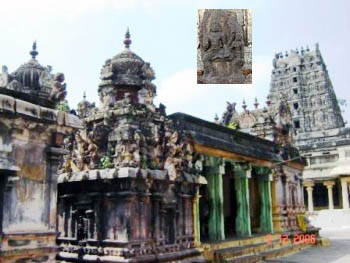Name of the Temple |
- Panchanadhīśhwarar Temple
|
Location |
- Located in Thiruvaiyāru near Thanjāvūr District, Tamilnādu, South India.
|
| How to reach there? |
- By Air: The nearest airport is Thiruchirāppaḷḷi, 55 km. To reach Panchanadhīśhwara temple take the State Highway 22 east.
- By Train : The nearest railway station is Thiruchirāppaḷḷi Railway Station, 55 km. To reach Panchanadhīśhwara temple take the State Highway 22 east.
- By Road: Thiruvaiyāru, where Panchanadhīśhwara is located, is connected by the State Highway 22 from Mélaiyūr to Thiruchchirāppalli and 27 from Paluvūr to Thanjāvūr. Also the National Highway 81 from Kāmāchipuram to Sethiathōppu, 83 from Thanjāvūr to Nagapaṭṭinam and 36 from Thanjāvūr to Ozhukarai are close.
|
Rulers/builders and Time Period |
- There are several inscriptions here relating the temple to Cholas, Pāndyas, Krishna Devarāya and other rulers.
- Karikāla Chola, Rājarāja Chola & Jāthavarman Sundhara Pāndyan are associated with Thiruvaiyāru.
- Uttharakailāsam was built by Rajaraja Chola’s wife (late 10th century) who made several endowments . Dakshinakailāsam was renovated by Rajendra Chola's wife.
|
Deity/Deities |
- Lord Śhiva called Aiyārappar
- Panchanadhīśhwarar and Ambāl called Aram Valarttha Nāyaki, Dhharma Samvardhhini
|
Architecture Style |
- This grand temple with five prakārams and a 7 tiered Rājagopuram covers a 15 acre area .
- Somaskandar (Ulagamāvīdhivitankar) is housed in a separate shrine in the 2nd prakāram, adjacent to the Japeśha Mandapam . The Śhivayoga Dakshināmūrthy shrine is also of great significance here.
- The shrine to Ambāl Dhharmasamvardhhini Amman, has two prakārams by itself.The outer prakāram houses the Dakshina Kailāsam, and the Uttara Kailāsam.
- To denote the primordial nature of Sound - Nādha Brahmam, there are spots in this temple designed to produce echos. The Śhivalingam here resembles that of Thiruvārūr.
|
Speciality |
- The temple is known as Dakshina Kailāsam and this is a Śhaivite shrine of great significance.
|
Other Special Features |
- A devotee by name Sucharithan was redeemed from untimely death by Śhiva in the form of a column of light (similar to the Mārkandeya legend of Thirukkadavūr&Vaikavūr).
- Agasthya is said to have obtained his dwarfed physical stature here. Ambal is said to have worshipped Śhiva with 2 measures of grains.
|
Special Reference to Performing Arts: |
- Muthuswāmi Dīkshithar composed 13 compositions in 8 vibhakthis in praise of Śhrī Thyāgarājeśhwara at Thiruvaiyār ( Listed down)
- Every year the death anniversary of Saint Thyāgarāja is commemorated on Bahula Panchami (mid-Jan) at his samādhi in Thiruvaiyāru with, appropriately, a music festival, the Thyāgarāja Ārādhanai. The best known Carnātic musicians join lesser known voices in singing the pancharathna kritis, the five compositions that are considered Thyāgarāja's gems or rathnas.
- The Pancharathna Kritis are:
- Jagadhānandha Kāraka - Rāga Nāta
- Dudukugala – Rāga Gaula
- Sādhinchane - Rāga Ārabhi
- Kanakana Ruchira - Rāga Varāli
- Endharo Mahānubhāvulu – Ragam Śhrī
|
Bibliography |
|















